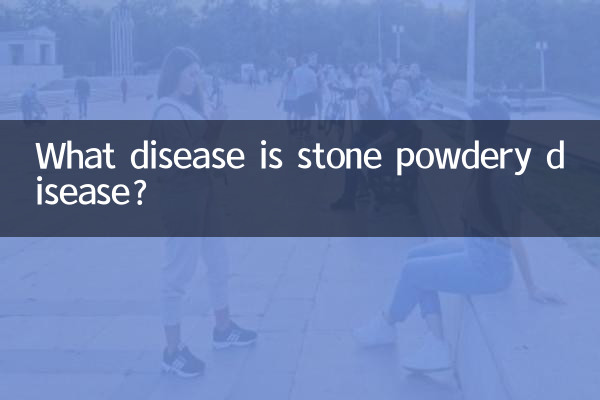What disease is stone powdery disease?
In recent years, the term stone powdery disease has appeared frequently on social media and health forums, attracting widespread public attention. This article will combine the hot topics and hot content on the Internet in the past 10 days to provide you with a detailed introduction to the definition, symptoms, causes, preventive measures and related data of stone powdery disease to help you fully understand this disease.
1. Definition of stone powdery disease

Stone powdery disease, medically known as "silicosis", is an occupational lung disease caused by long-term inhalation of dust containing free silica (such as quartz, granite, etc.). The disease is more common in occupational groups such as miners, construction workers, and stone processing workers. In recent years, new cases have also been caused by the rise of certain emerging industries (such as artificial stone processing).
2. Symptoms of stone powdery disease
Symptoms of stone powdery disease are usually divided into three stages: early, middle and late stages:
| stage | symptom |
|---|---|
| Early days | Mild cough, chest tightness, and shortness of breath can easily be misdiagnosed as a common cold or bronchitis |
| medium term | Persistent cough, blood in sputum, difficulty breathing, and fibrosis in the lungs |
| Late stage | Severe dyspnea and lung failure, which may be complicated by tuberculosis or lung cancer |
3. Causes of stone powdery disease
The main cause of stone powdery disease is long-term inhalation of dust containing free silica. The following are common occupational exposure scenarios:
| industry | Exposed scene |
|---|---|
| mining | Dust produced when mining quartz, granite and other ores |
| construction industry | Dust produced when cutting and polishing stone or concrete |
| manufacturing | Dust in artificial stone processing, ceramic production, etc. |
4. Preventive measures for stone powdery disease
The key to preventing stone powdery disease is reducing dust exposure. The following are recommended precautions:
| measure | Specific methods |
|---|---|
| engineering controls | Use wet work, local ventilation equipment, etc. to reduce dust generation |
| personal protection | Wear a dust mask (such as N95 or higher) |
| health monitoring | Conduct regular lung examinations to detect lesions early |
5. Hot topics about stone powdery disease on the Internet in the past 10 days
Here are some of the recent popular discussions about stone powdery disease on social media and news platforms:
| platform | hot topics |
|---|---|
| "Artificial stone processing workers collectively suffer from silicosis" triggers heated discussion | |
| Tik Tok | Short video "Real life of stone powdery patients" received millions of likes |
| Zhihu | The topic "How to avoid stone powdery disease? Occupational protection guide" has been read more than 500,000 times |
6. Current status of treatment of stone powdery disease
At present, there is no specific treatment for stone powdery disease, and the main methods are symptomatic treatment and delaying the progression of the disease. The following are common treatments:
| Treatment | illustrate |
|---|---|
| drug treatment | Use bronchodilators and anti-inflammatory drugs to relieve symptoms |
| Oxygen therapy | For terminally ill patients, long-term oxygen therapy improves quality of life |
| lung transplant | Lung transplantation may be considered for severely ill patients, but it is expensive and donors are scarce |
7. Summary
Stone powdery disease is a serious occupational disease and its harmfulness cannot be ignored. Through the introduction of this article, I hope readers can understand the definition, symptoms, causes and preventive measures of stone powdery disease. In particular, people engaged in related industries should strengthen their awareness of protection. At the same time, the whole society should also pay attention to occupational health issues, promote the improvement and implementation of relevant policies, and reduce the occurrence of stone powdery disease.
If you or someone around you has related symptoms, please seek medical treatment promptly and inform the doctor of your occupational exposure history for early diagnosis and treatment.

check the details

check the details